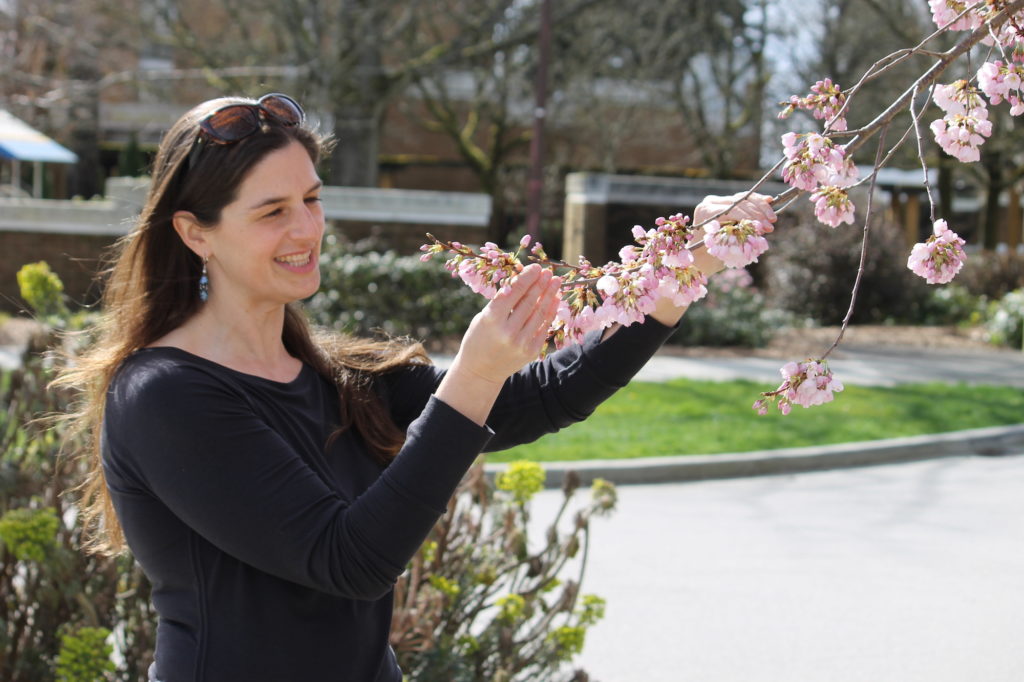Cherry blossoms attract huge crowds in spring, but predicting when they're at their peak is no easy feat. In order to do that accurately, scientists look at many factors including recent local weather patterns, temperatures and amount of daylight.
This year UBC climate change biologist Dr. Elizabeth Wolkovich in the faculty of forestry and colleagues had an idea. Why not get the public involved in determining peak bloom? Citizen scientists could draw on publicly available data and records to form predictions. Such a process could promote awareness of climate science and help scientists in their modelling work.
This was the genesis of the world's first international cherry tree prediction competition. Competitors were asked to forecast peak bloom for four cities famous for cherry blossoms: Kyoto, Japan, Washington D.C., Vancouver, B.C. and Liestal-Weideli in Switzerland. Eighty-one contestants across four continents formed 41 teams to take up the challenge and win up to $5,000 in prizes. The results will be announced in May.
We asked Dr. Wolkovich and her colleagues - Dr. Jonathan Auerbach and Dr. David Kepplinger, both data scientists and statistics professors at George Mason University in Fairfax, Virginia - to discuss what the competition could mean for climate change modelling.
Why did you decide to hold this competition?
Wolkovich: In my lab at UBC, we wanted to improve our model for predicting how trees respond to climate change, particularly by observing when they leaf out or flower. We decided to study cherry trees because we know a lot about their history-the record of peak bloom of cherry trees in Kyoto, Japan is the longest human record we have of recurring biological events. My collaborators and I then came up with this cherry blossom competition idea because we believe that having more people modeling cherry blossom flowering will bring us better models and better insights. Over the long term, we could apply this model to study the climate response of other plants and trees and scale up to improve models of carbon storage and climate change itself.
Auerbach: The combination of non-expert predictions can be incredibly accurate. For example, when contestants guess the number of jellybeans in the jar at the fair, the average is often alarmingly close. We wondered whether citizen scientists can similarly participate in cherry blossom prediction. Of course, the timing of cherry blossoms is not as simple as the number of jellybeans, so an open research question is how to best harness the wisdom of the crowd.

Dr. Elizabeth Wolkovich. Photo: Steph Troughton/UBC
What predictions are you seeing?
Wolkovich: The overall consensus is that the cherry trees will likely bloom between late March and early April. For Vancouver, the average predicted peak bloom date is April 2. The average prediction for Kyoto is April 3, for Liestal-Weideli, April 2 and for D.C., April 1.
Kepplinger: Two teams did correctly predict the D.C. peak bloom date, which the National Park Service called on March 22, within two days. However, we will wait to see the results from all four locations and the evaluations of our expert judges before determining the winners and identifying the best methods.
How did the contestants come up with their forecasts?
Auerbach: We saw a lot of new and interesting strategies for predicting peak bloom. Most contestants considered the meteorological data used by experts, such as temperature and rainfall. But many also considered additional factors to create compelling narratives and give their predictions an edge. For example, some factored in the population of the surrounding city or the concentration of greenhouse gases.
Kepplinger: The contestants explored more methods to model this complex phenological event than what can be done by the few experts in the field. The competition allows us to compare all these approaches to better understand which hold merit for future research.
Whether the predictions will hold up remains to be seen. But they could help enable longer-term forecasts of peak bloom dates than what is currently possible.
Will you hold another competition next year?
Wolkovich: We certainly hope to attract even more citizen scientists next year. With their help we'd love to extend the competition to address some major biological questions related to leafout. For example, how can we predict leafout for the different species and varieties of cherry and plum trees? Or, we know that winter cool temperatures partly determine leafout in many trees, including cherries, but modeling this has been a major hurdle-getting more people involved could crack this problem. Their combined insights can help us improve forecasting models and suggest new approaches that we can explore in the future.
Interview languages: English (Wolkovich, Auerbach, Kepplinger), German Kepplinger)






